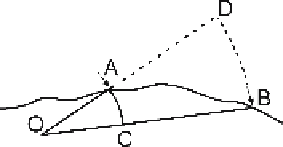Geology Reference
In-Depth Information
This example illustrates the importance of the cross section to structural interpre-
tation. The rule of constant bed thickness allows a few dips and the formation contact
locations to tightly constrain the geometry of the cross section. The rule works well
even though there is a small amount of thickening in the tightest hinge. The cross
section can, in turn, be used to revise the geologic map and the composite structure
contour map. The cross section provides the needed control for mapping the deeper
geometry. Extrapolation to depth using the composite-surface technique breaks down
if vertical lines through the control points pass through axial surfaces, as happens in
the forelimb of the Sequatchie anticline (Fig. 6.23). Composite surface maps (Sect. 3.6.2)
provide a good first approximation, but the final interpretation should be controlled
directly by cross sections based on multiple horizons.
6.4.2
Circular Arcs
The method of circular arcs is based on the assumptions that bed segments are por-
tions of circular arcs and that the arcs are tangent at their end points (Hewett 1920;
Busk 1929). This type of curve can be drawn by hand using a ruler and compass. The
resulting cross section will have smoothly curved beds. The method of circular arcs
produces a highly constrained geometry in which both the shape of the structure and
the exact position of each bed within the structure are predicted. When these predic-
tions fit all the available data, the cross section is very likely to be correct. If the strati-
graphic and dip data cannot be matched by the basic construction technique, as often
happens, dips can be interpolated that will produce a match. The basic method is given
first, then two techniques for dip interpolation.
6.4.2.1
Method
If the dips are known at the top and bottom of the bed (Fig. 6.24), the geometry of a
circular bed segment is constructed by drawing perpendiculars through the bed dips
(at A and B), extending the perpendiculars until they intersect (at O) which defines
the center of curvature. Circular arcs are drawn through A and B to define the top and
bottom of the bed.
This process is repeated for multiple data points to draw a complete cross section
(Fig. 6.25). The first center of curvature (O) is defined as the intersection of the normals
to the first two dips (A and B). The marker horizon located at point A is extended to
the bedding normal through B along a circular arc around point O. The next center of
Fig. 6.24.
Cross section of a bed that is a
portion of a circular arc. (Af-
ter Busk 1929)

